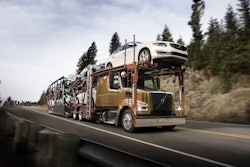
Late-night and daytime television are supported in large part by lawyers seeking out motorists involved in large truck crashes, and with good reason: it’s a lucrative business.
Large verdicts against trucking fleets are increasing dramatically, both in number and in size of awards, and have exploded by a factor of 11 in the last six years.
According to data compiled by the American Transportation Research Institute (ATRI), which created a trucking litigation database detailing information on 600 cases between 2006 and 2019, there were 26 cases with judgements in excess of $1 million during the first five years of the data. In the last five years there were nearly 300. From 2010 to 2018, ATRI found the size of verdict awards grew 51.7% annually while standard inflation grew 1.7% and healthcare costs grew 2.9% during the same period.
Rob Moseley, Founding Partner with Mosely Marcinak Law Group, said the issue is more than about plaintiffs and attorneys chasing big bucks, noting sizable jury verdicts “has had a stifling impact on motor carriers and industry stakeholders.”
Clay Porter, partner at Porter Rennie Woodard and Kendall, said the frequency in excessive awards “while not surprising, tells us that the trial system has gotten completely off track. Foundational changes are needed in the way we determine non-economic and punitive damages.”
All respondents to ATRI’s Litigation Impact Survey reported that insurers have had to increase premiums as a result of large jury verdicts. One motor carrier reported an increase in a single-year’s insurance rates of more than 100%.
“One respondent specified that ‘low risk’ motor carriers are experiencing 8% to 10% increases in insurance costs, while new ventures and average-to-marginal carriers are experiencing a 35% to 40% annual increase – a trend that has occurred for three consecutive years,” ATRI’s report stated. “In terms of fleet size, it appears that size matters.”
Root causes
ATRI concluded that two primary factors affect the size of an award verdict: characteristics of the crash and litigation factors.
Crash factors, according to ATRI, include injuries sustained, the number of cars involved and the number of deaths. Litigation factors include the presence of expert witnesses, for example.
When an expert witness is called in favor of the defense and not for the plaintiff, ATRI found a sizable decrease in the average size of the verdict, cutting the resulting mean verdict from $3.1 million down to $2.7 million.
Children also play a large role in the size of the verdict. If a child was involved in the crash and related litigation, the verdict increased 1,687% – from $2.3 million to $42.3 million.
Accidents that included hours-of-service or log book violations, a poor driving history, driving under the influence of controlled substances, fleeing the scene or health-related issues saw a 100% verdict rate in favor of the the plaintiff. Distracted driving and fatigue result in a greater than 90% win rate for the plaintiff.
Types of crashes
Average damages also vary by the type of crash in which the truck was involved. ATRI found that spins and rollovers were the most expensive crash type by far, with an average verdict of almost $15 million – more than twice the average verdict of standard collisions, the next highest crash type.
Crashes that caused a spinal cord injury doubled the average jury awards, coming in at just under $3.5 million. Rear-end crashes in a work zones lead to the highest award among rear-end crashes, with an average award of more than $7 million.
Driver safety systems have evolved in the last 15 years from niche categories to virtually ubiquitous technology, but the system itself is only supplemental to good driving habits.
“Full stability has been mandated across the industry, air disc brakes help significantly reduce stopping distance, while our family of Wingman Fusion collision mitigation system is standard at a number of OEMs across North America,” said TJ Thomas, Bendix Commercial Vehicle Systems Controls Group director of marketing and customer solutions. “These and other technologies work to help mitigate both the number and severity of crashes. What’s most important to keep in mind, however, is that safety technologies complement safe driving practices. No commercial vehicle safety technology replaces a skilled, alert driver exercising safe driving techniques and proactive, comprehensive driver training. Responsibility for the safe operation of the vehicle remains with the driver at all times.”
According to the National Transportation Safety Board, serious injuries to drivers are reduced by 79% in vehicles that have radar based active emergency brake systems. Kelly Gedert, Daimler Trucks North America’s vice president of on-highway market development, noted that since its introduction in 2015, Detroit Assurance has been at the cutting edge of advanced driver assistance systems and “today, Detroit Assurance 5.0 is the industry’s only full SAE Level 2 suite of safety systems, enhancing safety for all on the road.”
Lawyers push back
The Academy of Truck Accident Attorneys (ATAA) balked at many of ATRIs findings, namely the notion that the trucking industry as a whole has been victimized by large jury verdicts.
“The real problem is that insurance minimum limits haven’t been updated in over 40 years. Taxpayers end up paying for the lifetime care of trucking victims when at-fault motor carriers should pay,” said ATAA co-founder Michael Leizerman. “Large truck companies don’t have to pay the few $10 million-plus verdicts, they have insurance to cover this. But the trucking companies with only minimum insurance can’t pay for the harm they cause.”
ATAA’s education chair Andy Young pointed to ATRI’s findings that fleets with a basic safety violation lose cases 100% of the time as evidence that trucking’s bad actors are the ones suffering most.
“When trucking companies do what they’re supposed to do, everyone gets where they’re going alive and there is no need for litigation,” he said. “But when trucking companies fail to follow FMCSA guidelines, regulations, and just plain common sense, people get hurt or killed. Time and time again, the only way trucking companies change their ways is through the fear of a major verdict.”










